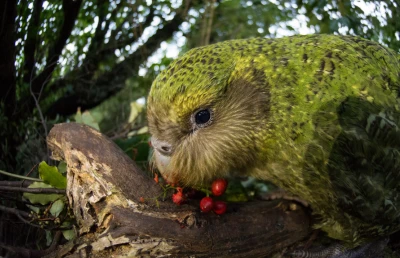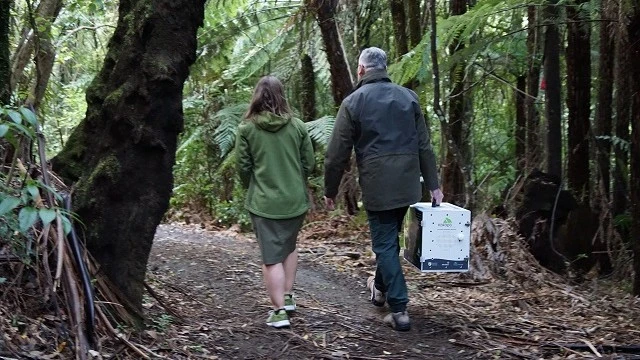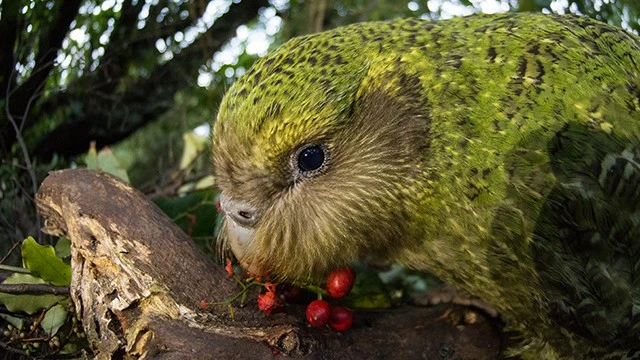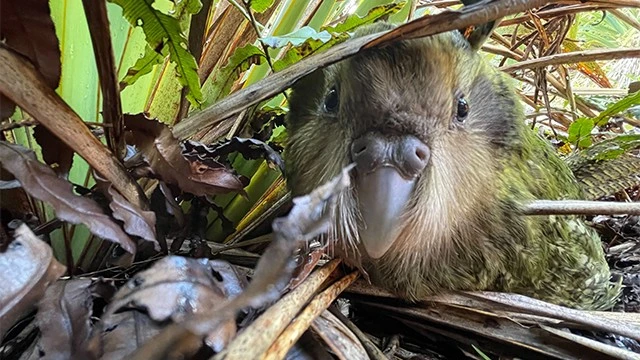For the last 7 years, we've been proud to support the Kākāpō Recovery Programme and wanted to take some time to hit the rewind button to see just how far we've come.
Celebrating 7 years of partnership
Helping to bring kākāpō back from the brink of extinction Transcript
Music plays: View of native bush with two rangers releasing a kākāpō from a cage. Kākāpō walks to the front of the video.
See on screen the word Meridian, the company logo, and the words “The power to make a difference.”
The scene changes to an older scene with a Department of Conservation (DOC) person releasing a kākāpō from a wooden carry case. The kākāpō spreads its wings as it emerges from the box.
Neal Barclay, Meridian’s Chief Executive is speaking: Meridian is very proud to have been involved with DOC and Ngāi Tahu on the Kākāpō Recovery Programme.
See a ranger wearing a headlight at night, holding a tracking antenna.
See a helicopter landing and unloading three animal transporter containers while a small group of people wait to meet them at the Manapouri power station.
The scene widens to show the helicopter in front of a building near the Manapouri power station, on a cold and cloudy day.
Words on screen: Kākāpō Recovery is a world class programme that’s been run by DOC since 1995 when there were only 51 known birds.
See a kākāpō poking their head out of the animal transporter container.
See two kākāpō in a display with a small group of people watching.
Neal Barclay speaks: In 2016, five chicks hand-reared in Invercargill by Kākāpō Recovery stopped at Meridian’s Manapouri power station before their release on Pukenui to start their new life in the wild.
See Nicola Toki, a threatened species ambassador, talking with a small group of people.
Nicola talks to camera: It is absolutely my privilege to announce the partnership today. We are so excited to be working with you all, and we hope that you enjoy our special guests.
See two kākāpō up close and facing the camera while one more kākāpō comes in to shot from behind.
See Neal Barclay sitting with a Kākāpō book, toy and t shirt behind him.
Neal talks to the camera: We’ve had some success since that time with the number of kākāpō increasing to 248.
Neal Barclay continues to speak as the scene changes: That’s still not many though, so it’s super pleasing to see this programme extended to include this new habitat, Sanctuary Mountain Maungatautari.
See a shot of coastal New Zealand with a beach and mountain in the background. A map of New Zealand shows Whenua Hou/Codfish Island, Pukenui/Anchor Island and Te Kakahu o Tamatea/Chalky Island and the words “Today, 248 kākāpō breed on three predator-free islands......double the population since we became partner”. Disclaimer on screen reads *known birds as at July 2023.
See people gathering for the release of the kākāpō in their new habitat while Ngāti Koroki Kahukura Trust co-chair Rahui Papa welcomes the birds with a karakia.
Words appear on screen: “The transfer to Sanctuary Mountain Maungatautari is the first time in over 30 years that the Kākāpō has lived on the mainland.”
See DOC and community representatives carry animal transporter boxes to the release area and open the door.
See a kākāpō emerge into their new habitat and walk through the native bush.
Neal Barclay says: We’ve also been able to leverage some of our core capabilities in terms of electrical infrastructure to support the facilities on the islands where the birds have resided.
See a technician fixing machinery in the kākāpō habitat with the words “Turbine power system” on screen.
The scene then changes to show a large area of Chalky Island from the air, where you can see solar panels and two DOC buildings. Words on screen are “Solar power system”.
See a kākāpō hatching from an egg.
See a person carrying a kākāpō covered in a blanket into a DOC hut followed by another worker, both in high visibility jackets.
Neal Barclay continues to speak: And that’s allowed DOC to continue to operate incubators and their huts and so forth.
See Mark Allen – Site manager 2006 – 2020 talking to the camera outside a hydro station.
Mark Allen says: It’s really important that the guys are taking the right equipment and the right mindset down to the island. There is a lot of planning involved and there’s a lot of number 8 wire stuff and be able to think outside the box.
See a small plane landing on a beach.
See a technician fixing machinery outside in the new habitat.
See a large kākāpō looking into the camera and sitting on a branch in its habitat.
Neal Barclay speaks: The Kākāpō Programme is essential for saving the species from extinction. Meridian is super proud of our contribution.
See a volunteer walking through nature with the words “Volunteering on the island” on screen.
See a volunteer cleaning a water bowl.
Volunteer Tui Wagstaff says: Now we are going to do some cleaning.
See Neal Barclay sitting and speaking to the camera: And I think that the partnership with DOC and Ngāi Tahu has the power to make a difference, and we’ll continue to do so.
Music plays. See a close up of a large kākāpō in a glass display cabinet.
See a person looking at the kākāpō through the glass.
See a picture of Sanctuary Mountain covered in clouds.
See a kākāpō looking at the camera while sitting on the branch in the display.
See a blue screen and the words: Meridian and the company logo. Then the website www.meridian.co.nz/kākāpō appears on screen.
Also shown is the Department of Conservation Te Papa Atawhai and logo. Kākāpō Recovery and logo. Te Runanga o NGĀI TAHU and logo.
Together alongside the Department of Conservation (DOC) and Te Rūnanga o Ngāi Tahu, we're committed to helping bring this taonga species back from the brink of extinction.
Together we truly have the power to make a difference.
Committed to preserving Kākāpō

Keep Reading


